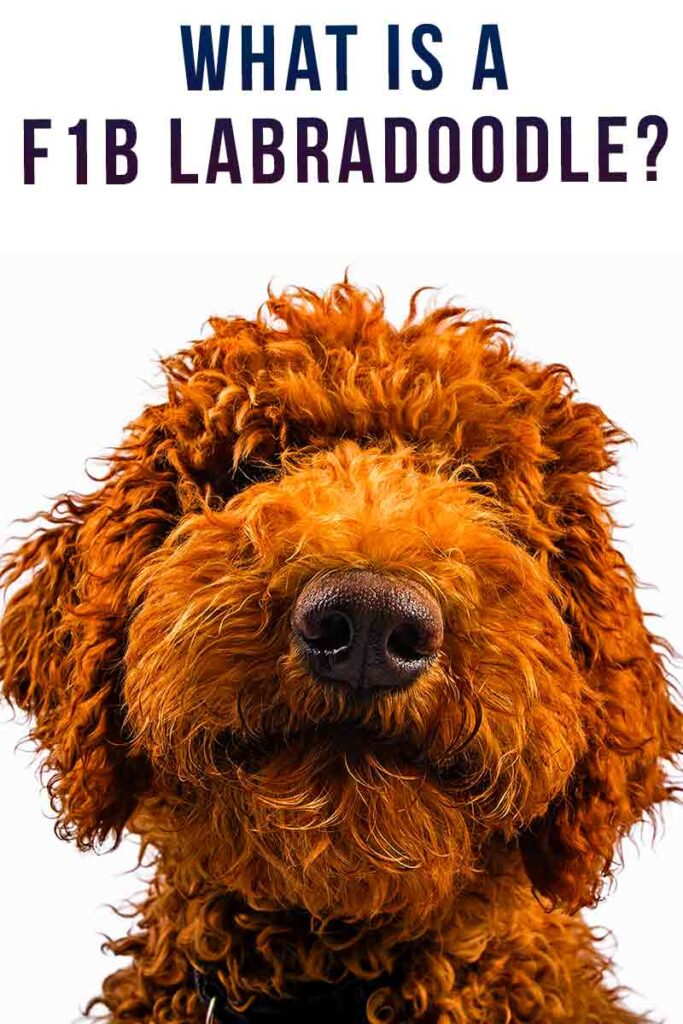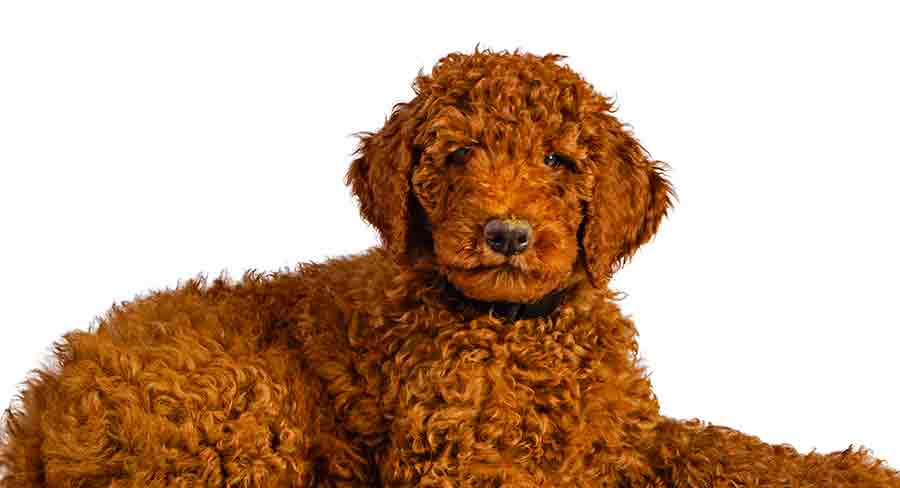An F1b Labradoodle is the offspring of a first generation Labradoodle, and a purebred Labrador Retriever or (more usually) a Poodle.
Therefore, F1b Labradoodles usually have a greater proportion of their genes in common with the Poodle. Unlike a first generation Labradoodle, which is always 50% Lab and 50% Poodle.
So, understanding labels like F1b is very helpful for anticipating what a puppy might be like when they grow up.
Understanding Labradoodle Generations
Designer dogs are the result of deliberately mixing different pedigree dog breeds. The Labradoodle is arguably the most famous example of this!
Puppies are often offered for sale described as F1, F2, F1b and F2b Labradoodles, etc.
This is a naming convention which tells you how many generations removed a puppy is from their closest purebred ancestor.

The “F” stands for filial.
It comes from the Latin word “filialis,” which means son.
It tells you the dog is not purebred.
Let’s Start With F1
And F1 Labradoodle is a cross between a purebred Labrador Retriever and a purebred Poodle.
The number 1 means first generation, and they’re what most of us think of when someone says ‘Labradoodle’.
F1 Labradoodles inherit half of their genetic code from their Lab parent, and half from from their Poodle parent.
Their appearance and behavior are somewhat unpredictable, because they can inherit traits from either parent. Luckily, Labs and Poodles have a lot in common anyway!
What is an F1b Labradoodle?
The “b” stands for backcross.
F1b means that this is the offspring of a first generation (F1) Labradoodle backcrossed with a purebred Labrador or Poodle.
Almost invariably, it is an F1 Labradoodle backcrossed with a Poodle. We’ll see why in a minute.
Genetically, this kind of F1b Labradoodle can be anything from 50:50 Labrador and Poodle, to 100% Poodle.
But on average, they are 75% Poodle and 25% Lab.
Wait, what?
Don’t worry, we’ll walk you through it!
A dog’s DNA is written in pairs of genes. In each pair, one gene is contributed by their mom, and one by their dad.
Another way to look at this is that mom and dad each contribute half of their genetic code, to create a new whole.
But which half of their genetic code they contribute is completely random.
Let’s apply that to the F1b Labradoodle.
And let’s assume they have a purebred Poodle parent. All of the genes that parent contributes are Poodle genes. Which means our F1b Labradoodle puppy is going to be at least 50% Poodle.
Their other parent is an F1 Labradoodle. They have 50% Poodle genes and 50% Labrador genes. Half of those genes will be selected at random and passed on to each of their puppies.
It’s possible (but improbable) that all of the Poodle genes will be selected, and all of the Labrador genes will be left behind. Resulting in an F1b Labradoodle which has 100% Poodle DNA.
It’s also possible (but improbable) that all the Labrador genes will be selected, and all of the Poodle genes will be left behind. Resulting in an F1b Labradoodle which has 50% Poodle genes and 50% Labrador genes, the same as an F1 Labradoodle.
Statistically though, an F1 Labradoodle is more likely to pass on a mix of their Labrador and Poodle genes.
Sometimes they might pass on close-to-equal proportions of each. And sometimes they will pass on more of one than the other.
Why Is This Important?
Sometimes genetic inheritance surprises us.
Instinctively, many of us would assume that an F1b Labradoodle is 75% Poodle and 25% Labrador.
We might also expect to be able to predict their physical traits and temperament more accurately than those of an F1 Labradoodle.
By assuming they’re going to be more Poodle-like.
Some breeders even rely on us making that assumption.
But in fact, the genetic inheritance of F1b Labradoodles is still very variable, and so too are their looks and temperaments. Even within a single litter.
Why Would You Want an F1b Labradoodle?
Labradoodles make terrific family dogs.
They combine two loyal, loving, friendly, and highly intelligent breeds that are easy to train and generally get along with children and other animals.
But you might wonder now why so many people want an F1b Labradoodle in particular.
If you’ve been researching Labradoodle breeders, you may even have noticed that some charge more for a first-generation backcross.
And the reason is that F1b Labradoodles with a purebred Poodle parent are more likely to inherit the genes for a curly, non-shedding coat.
This coat not only gives them an adorable “teddy bear” appearance that so many people find desirable, it also means that these dogs shed very little.
A Poodle coat will cut down on vacuuming and strays hairs on clothes and furniture.
Households with allergy sufferers often choose F1b Labradoodles to eliminate or reduce their symptoms.
But are they truly allergen-free?
Are F1b Labradoodles Hypoallergenic Dogs?
According to the Asthma and Allergy Foundation of America about one in every ten people has dog allergies.
If you’re a dog lover, and you or someone in your family is one of these people, it can be a crushing blow to think you’ll never be able to enjoy the love and companionship of a canine friend.
The idea of a hypoallergenic dog that doesn’t shed or produce allergens seems like the perfect solution.
But is any dog really hypoallergenic?
The Truth About Dog Allergies
It’s actually not a dog’s hair that triggers allergic symptoms, but inhaling tiny airborne protein molecules found in their dander, saliva, and urine.
A 2011 study measured the volume of these proteins in 173 homes with ‘hypoallergenic’ dog breeds.
The results showed that there was no difference in the amount of allergens in homes with hypoallergenic dogs compared to those with other breeds.
In fact, a 2012 study found that coat samples from ‘hypoallergenic’ breeds actually had significantly higher amounts of allergenic proteins on their surface.
And the truth is that every dog is an individual with their own unique profile of chemical proteins.
People also possess their own unique body chemistry and immune systems. So while one dog may trigger your allergies, another might not bother you at all.
And their breed, or coat type, is not an accurate predictor of that.
Grooming an F1b Labradoodle
The F1b Labradoodle coat also requires some serious attention to grooming.
Before you commit to getting an F1b Labradoodle make sure you’re prepared to care for their coat on a regular basis.
Lack of brushing can cause their curls to become matted and tangled.
Although these dogs don’t shed much, the hair they do lose can get trapped in their tight curls, and form painful mats.
Mats also trap moisture and dirt close to the skin, which increases bad odor and the risk of fungal infections.
So, F1b Labradoodles need regular visits to a professional groomer, or DIY washing and clipping.
What is an F1b.b Labradoodle?
An F1b.b Labradoodle is usually a cross between an F1b Labradoodle and a purebred Poodle.
This is a second backcross, so that’s where the second “b” comes from.
On average F1b.b Labradoodle is 87.5% Poodle and 12.5% Labrador Retriever.
The rules of genetic inheritance still mean that some individuals have a greater proportion of Labrador DNA than that. But overall, repeated back crossing to Poodles also starts to make F1b.b Labradoodles more predictable Poodle-like.
And there’s a higher probability of inheriting the curly Poodle coat.
What is an F2 Labradoodle?
F2 Labradoodles are second-generation dogs – both parents are F1 Labradoodles.
And their closest purebred ancestor is no longer a parent, but a grandparent.
On average they are still 50% Labrador and 50% Poodle. But that’s just an average now – in fact the genetic makeup of F2 dogs is highly variable.
So puppy parents adopting an F2 dog need to be prepared for their puppy to grow up with any combination of Labrador and Poodle traits.
Including a variety of coat types from very curly to straight and short.
F1b Labradoodle – Summary
Labradoodles combine two amazingly smart dogs who are known to be loyal, loving, and active.
Choosing an F1b Labradoodle with a purebred Poodle parent increases the probability that they dog will have the curly or wavy Poodle coat that’s so desirable.
But it doesn’t guarantee it.
And while it’s true that the Poodle coat sheds less, it’s important to realize that no dog is completely free of allergens.
And then there’s taking care of all that luscious fur.
Be prepared to comb through those amazing curls at least twice a week, and visit the groomer every 6 weeks.
Think of it as quality time spent bonding with your F1b Labradoodle!
References and Further Reading
Shouldice, VL et al., “Expression of Behavioural Traits in Goldendoodles and Labradoodles,” Animals (Basel)., 2019
Asthma and Allergy Foundation of America
Nicholas, C. E. et al, “Dog allergen levels in homes with hypoallergenic compared with nonhypoallergenic dogs,” American Journal of Rhinology and Allergy, 2011.
Vredegoor et al, “Can F1 levels of hair in different dog breeds – lack of evidence to describe any dog as hypoallergenic,” Journal of Allergy and Clinical Immunology, 2012
Welle, MM, et al., “The Hair Follicle: A Comparative Review of Canine Hair Follicle Anatomy and Physiology,” Toxicologic Pathology, 2016

